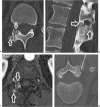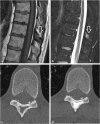Percutaneous Treatments of Benign Bone Tumors
- PMID: 30402015
- PMCID: PMC6218259
- DOI: 10.1055/s-0038-1673640
Percutaneous Treatments of Benign Bone Tumors
Abstract
Benign bone tumors consist of a wide variety of neoplasms that do not metastasize but can still cause local complications. Historical management of these tumors has included surgical treatment for lesion resection and possible mechanical stabilization. Initial percutaneous ablation techniques were described for osteoid osteoma management. The successful experience from these resulted in further percutaneous image-guided techniques being attempted, and in other benign bone tumor types. In this article, we present the most common benign bone tumors and describe the available results for the percutaneous treatment of these lesions.
Keywords: benign bone tumor; cryoablation; interventional radiology; osteoid osteoma; radiofrequency ablation; vertebral hemangioma.
Figures



Similar articles
-
Radiofrequency ablation of osteoid osteoma.Acta Biomed. 2018 Jan 19;89(1-S):175-185. doi: 10.23750/abm.v89i1-S.7021. Acta Biomed. 2018. PMID: 29350646 Free PMC article. Review.
-
Benign Spine Lesions: Advances in Techniques for Minimally Invasive Percutaneous Treatment.AJNR Am J Neuroradiol. 2017 May;38(5):852-861. doi: 10.3174/ajnr.A5084. Epub 2017 Feb 9. AJNR Am J Neuroradiol. 2017. PMID: 28183835 Free PMC article. Review.
-
CT-guided percutaneous cryoablation of an osteoid osteoma of the rib☆.Radiol Case Rep. 2019 Jan 4;14(3):400-404. doi: 10.1016/j.radcr.2018.12.010. eCollection 2019 Mar. Radiol Case Rep. 2019. PMID: 30627298 Free PMC article.
-
Osteoid osteoma: Contemporary management.Orthop Rev (Pavia). 2018 Sep 25;10(3):7496. doi: 10.4081/or.2018.7496. eCollection 2018 Sep 5. Orthop Rev (Pavia). 2018. PMID: 30370032 Free PMC article.
-
[Percutaneous radiofrequency ablation of benign bone tumors: osteoid osteoma, osteoblastoma, and chondroblastoma].Radiologia. 2009 Nov-Dec;51(6):549-58. doi: 10.1016/j.rx.2009.08.001. Epub 2009 Oct 28. Radiologia. 2009. PMID: 19863982 Spanish.
Cited by
-
Cystic Echinococcosis of the Ilium Treated with Curettage and Microwave Thermoablation Followed by Bone Cement Installation: A Novel Treatment Technique for a Rare Disease.Case Rep Orthop. 2021 Jun 24;2021:5533183. doi: 10.1155/2021/5533183. eCollection 2021. Case Rep Orthop. 2021. PMID: 34258091 Free PMC article.
-
Radiofrequency ablation for the treatment of a presumed enchondroma in the flat bones of the pelvis.Skeletal Radiol. 2023 May;52(5):1057-1061. doi: 10.1007/s00256-023-04291-x. Epub 2023 Feb 11. Skeletal Radiol. 2023. PMID: 36773084
-
Management of Osteoblastoma and Giant Osteoid Osteoma with Percutaneous Thermoablation Techniques.J Clin Med. 2021 Dec 7;10(24):5717. doi: 10.3390/jcm10245717. J Clin Med. 2021. PMID: 34945013 Free PMC article. Review.
-
Percutaneous Curettage and Local Autologous Cancellous Bone Graft: A Simple and Efficient Method of Treatment for Benign Bone Cysts.Arch Bone Jt Surg. 2022 Jan;10(1):104-111. doi: 10.22038/ABJS.2021.55189.2747. Arch Bone Jt Surg. 2022. PMID: 35291234 Free PMC article.
-
Full-Endoscopic Resection of Osteoid Osteoma in the Thoracic Spine: A Case Report.Int J Spine Surg. 2021 Feb;14(s4):S78-S86. doi: 10.14444/7169. Epub 2021 Jan 18. Int J Spine Surg. 2021. PMID: 33900949 Free PMC article.
References
-
- Rosenthal D I, Alexander A, Rosenberg A E, Springfield D. Ablation of osteoid osteomas with a percutaneously placed electrode: a new procedure. Radiology. 1992;183(01):29–33. - PubMed
-
- Tsoumakidou G, Thénint M A, Garnon J, Buy X, Steib J P, Gangi A. Percutaneous image-guided laser photocoagulation of spinal osteoid osteoma: a single-institution series. Radiology. 2016;278(03):936–943. - PubMed
-
- Huang A J. Radiofrequency ablation of osteoid osteoma: difficult-to-reach places. Semin Musculoskelet Radiol. 2016;20(05):486–495. - PubMed
-
- Klein M H, Shankman S. Osteoid osteoma: radiologic and pathologic correlation. Skeletal Radiol. 1992;21(01):23–31. - PubMed

